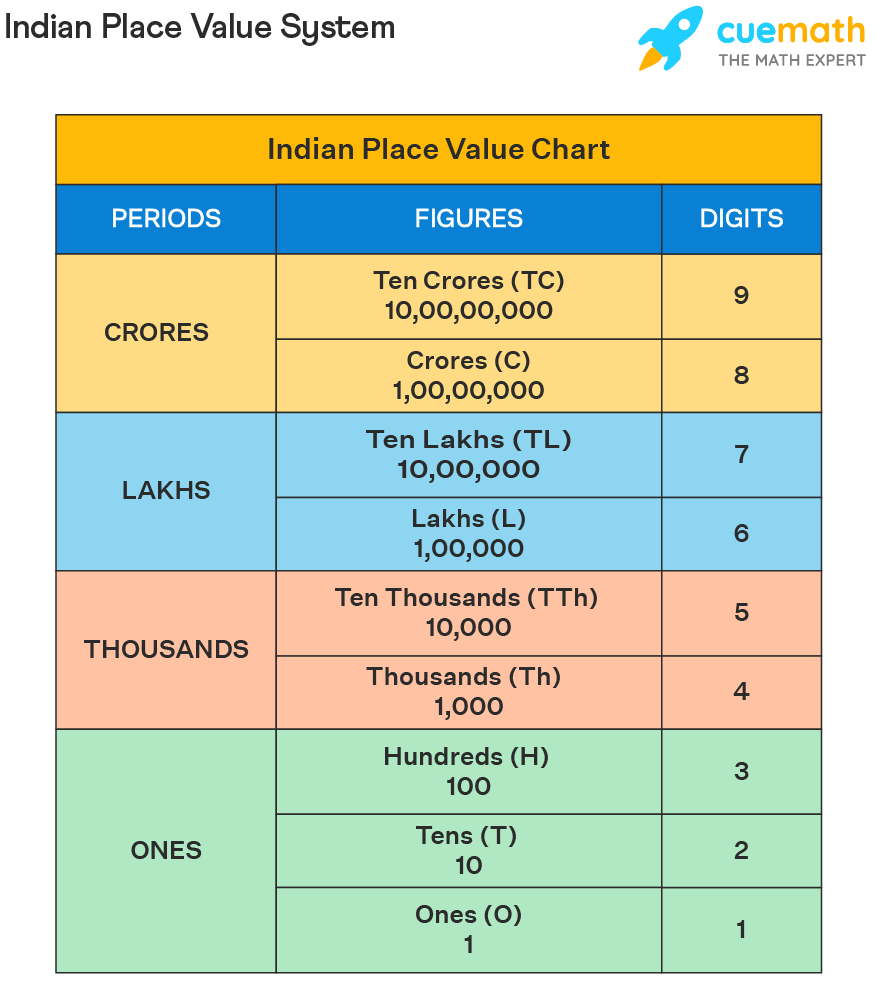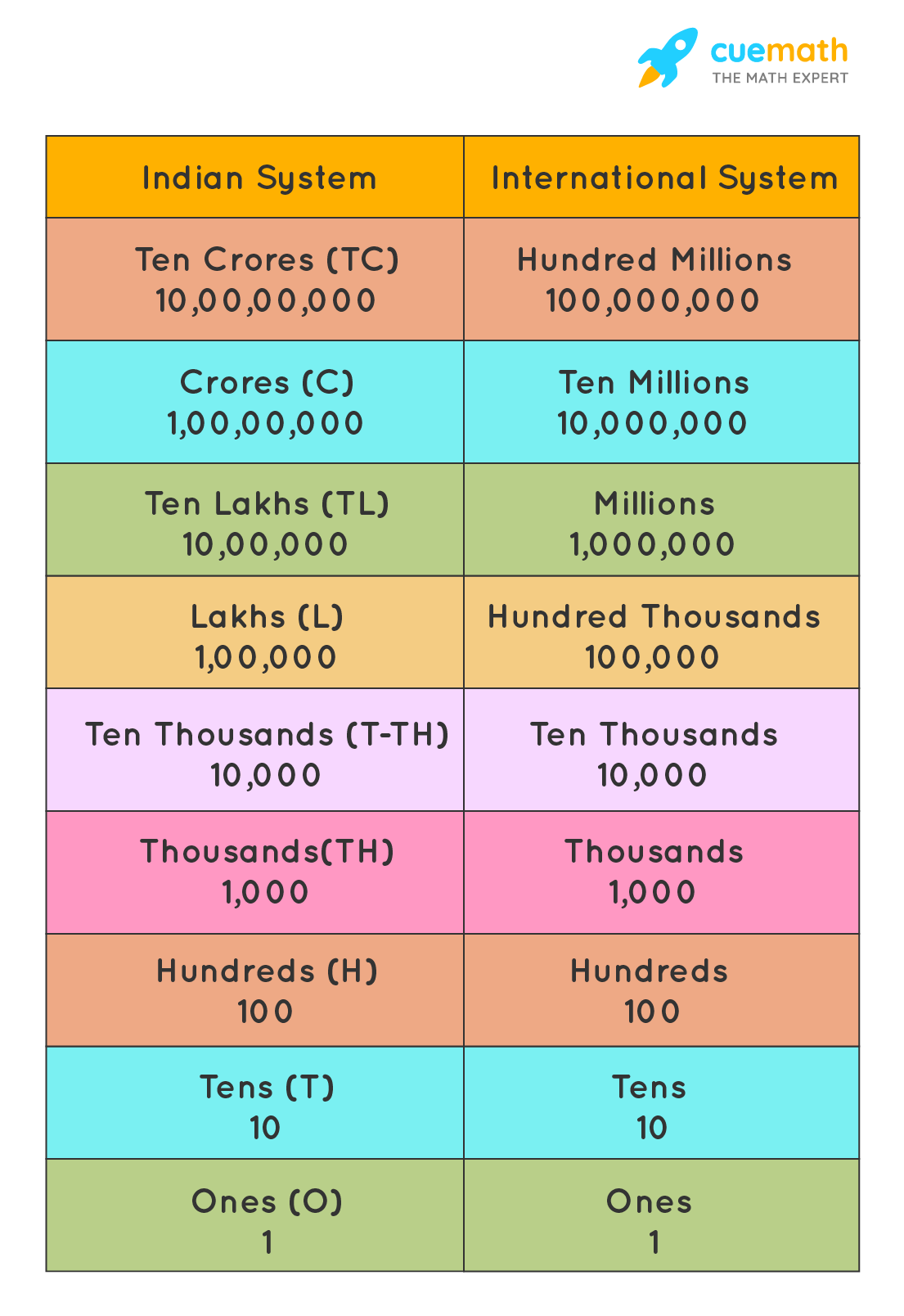
[NCERT] Class 6th Mathematics Chapter 1 Indian & International system of numeration YouTube
Solution The main difference between the Indian and International numeral system is the placement of commas (separator). In the Indian system, lakhs and crores are written after thousands, whereas in the International system, millions and billions are written after thousands.

Numbers Upto 7Digits Indian & International System 7 digit numbers
The Indian and the international number systems have different ways of expressing numbers in words. Indian: 2,48,64,701 (This can be read as two crores forty-eight lakhs sixty-four thousand seven hundred and one) International: 24,864,701 (This can be written as twenty-four million, eight hundred sixty-four thousand seven hundred and one)

Comparison of Indian and International System YouTube
For example, in the Indian place value system, the commas in the lowest ten-digit number 1,00,00,00,000 are placed 3:2:2, but in the International place value system, the commas are placed 3:3:3. This indicates that the numbers in all the periods are separated by a comma after every three digits, starting from the right end.

Indian Numeral System Indian Number System Definition and Examples
The Indian numeral system (or system of numeration) is a kind of writing that was adopted for the purpose of conveying numbers in India. It is a mathematical notation for consistently describing numbers in a particular set using digits or other symbols. This number system is composed of the usual numbers we see in the International System: 0 to 9.

Indian and International system Number systemReading number in Indian & International system
Digit 1-Units Digit 2-Tens Digit 3-Hundreds Digit 4-Thousands Digit 5-Ten Thousands Digit 6-Lakhs So let us take a random 6-digit number like 2,31,273 (Indian System) and 231,273 (International System) and see how it gets decomposed. Now, observe the decomposition of the same number as per the International Place Value Chart.

Numbers in Indian & International system Place Value Chapter 3 & 4 class 6 maths ICSE
The numeral system is of two kinds - Indian Numeral System and the International Numeral System. The Indian numeral system is widely used in India among Hindus while the International numeral system is used everywhere else. Let us learn more about the international number system and solve a few examples for better understanding.

Comparison between Indian and International System /Class 6/Learn And Score YouTube
Flexi Says: In the Indian numeral system, the various periods from the right are: Ones, thousands, lakhs, crores and so on.. While in the International numeral system, periods from the right are: Ones, thousands, millions, billions and so on.. The International numeral system uses separators (commas) differently from the Indian norm. Instead of grouping the rightmost three digits (until the.

Hazar Ka English Kya Hota Hai Mutabikh
Indian System vs International System Let us learn how the n umbers are compared in both the systems of numeration with the help of this chart given below. The chart also shows the place values of 7-digit numbers in both the systems, the Indian place value system and the International place value system. Place Values in 7-Digit Numbers

Indian Place Value System
International Number System 1 10 100 1,000 10,000 100,000 1,000,000 10,000,000 100,000,000 1,000,000,000 One Ten Hundred Thousand Ten Thousand Hundred Thousand One Million Ten Million Hundred Million One Billion Million has 6 zeroes. Billion has 9 zeroes.. Indian and International System of Numeration; Indian and International System of.

Numbers Upto 7Digits Indian & International System 7 digit numbers
An international number system (INU) is a system for representing numbers that divides them into groups or periods. These groupings or periods aid us in accurately interpreting huge numbers. The international numbering system uses comparable groups or periods but the commas are placed differently. Number Names in International Number System

Indian system & international system YouTube
In the International place value system, we have three periods: ones, thousands, and millions, for the nine places from right to left. Each period contains three places. Ones period: This is the first period consisting of three places: ones, tens, and hundreds.

Numbers Up To 6 Digits Solved Examples Numbers Cuemath
The lowest number at tens place is 10, and in words it can be written as Ten. After ten (10), the numbers from 11 to 19 are written in words as Eleven, Twelve, Thirteen, Fourteen, Fifteen, Sixteen, Seventeen, Eighteen and Nineteen. The next number is 20 i.e. Twenty. After twenty, all the numbers are written in pattern, such as Thirty, Forty.

Explain How the Digit 7 Can Have Different Values
In this article, we will learn about the two most important numeral systems: Indian and International, their place value, placement of zeros, the difference between Indian and International number system, and examples of writing number names with solved examples and FAQs. What are Numerals?

prepare a chart on indian and international number system Brainly.in
The Indian numbering system uses separators differently from the international norm. Instead of grouping digits by threes as in the international system, the Indian numbering system groups the rightmost three digits together (until the hundreds place), and thereafter groups by sets of two digits. [3]

Ones Tens Hundreds Thousands Chart India dreamswhites
The Indian system employs lakhs and crores units. The international system is based on a total of \(10^3\) variables (ten to the power three) After the hundredth place, the Indian system is based on \(10^3\) (ten to the power three), followed by two digits divided. Many countries throughout the world have adopted the international system.

INDIAN AND INTERNATIONAL SYSTEM OF NUMERATION.. YouTube
The Indian place value chart is based on the Indian numeric system, whereas the international place value chart uses the Internationally Recognized Numeric System. The primary distinctions between the Indian and International numeric systems are the location of separators (commas) and the naming of separate place values.